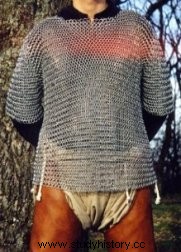A hauberk is a type of male dress, or, from the point of view of armament, it is this same dress made of ring mail fabric (see ring mail and chain mail) and intended for body protection .

Due to its annular mesh construction, this harness is flexible, unlike with numerous coats of arms and armour. It is however not excluded that some hauberks were made in jazeran mesh (jaseran), however this was undoubtedly extremely rare.
17th century definition
Hauberk, m. sharp. It is properly a coat of mail with sleeves and gorget, in the 2nd book of Amadis:Nevertheless Amadis got up very lightly even though he had remained a section of spear in the sleeve of his hauberk, and in the first book; Amadis reached him, and gave him a blow with the end of the sword, with which he split his hauberk all along the loins. It is also called Haubergeon in diminutive On the Calendar, We wear the haubergeon of humility against pride. The former French men-at-arms of three hundred years in addition, did not commonly use the haulsecol, braçals ne cuyssols, covering the hauberk those parts of the body on which they wore the iron coat of arms in tatters in the fauldiere, the escu hanging from the neck in a scarf, greves and shoes of steel blades, and gauntlets for all defensive weapons, as can be seen in the ancient sepulchers of the said time. Jehan the Mayor at the book. 1. chap. 22. of Illustrations:Si generally commanded everyone to take such armor as they found on the face of it. If like old lacquers swell of cotton, hauberks of double mesh, and lasserans rust, etc. Today the man-at-arms wears the body of cuyrasse instead of the said hauberk and coat of arms, the haulsecollar, braçals, and haunches instead of the gorget, sleeves and tassets of iceluy haulbert, see Fief de Haubert. Sic Thresor of the French language by Jean NICOT (1606)
Ring mesh has been known in Eastern Europe and the Near East since antiquity. It seems, for these territories, to have been invented by the Celts (Gallic) and spread by the Roman armies. During the fall of the Roman Empire, this type of defense seems to have been gradually forgotten, in favor of broignes, easier to manufacture and less expensive.
In the 11th or 12th century, Western warriors had to fight against, or with, Greek, Levantine, Arab and North African fighters. These regions had retained the annular coat, often coupled with a cuirass of scales. Noting the advantages of such defenses, they interpreted them by adapting them to their culture. The shape of the dresses (hauberk) already used for broignes was taken up to build "mail hauberks". The meaning of the word hauberk gradually varied to specialize as a ring mail dress.
The 14th century saw the size of clothing, both civilian and military, decrease. The Hauberk thus decreased in the same way and the "small" hauberk (Haubergeron) became the rule. The haubergeron is what is called “Cotte de mail” in vernacular French.
Shape
The shape of the hauberk and that of a dress, generally with long sleeves, slipping on through the collar. In order to allow riding, the hauberks were usually split on the front or on the side.
The exact shape (size, width of the sleeves, location and length of the slits, etc.) has varied over time, and according to geographical origin.
The Cleveland Museum of Art gives several examples of hauberks and haubergerons.
Controversy over the first hauberks
The first hauberks were made of Norman mesh (a variant of ring mesh. There is some controversy about their date of creation.
One school dates the first hauberks to the early/mid-11th century. During pilgrimages to Jerusalem, Norman warriors stopped and settled in Italy. At that time, part of Italy (Lombardy, Sicily) was partly under Greek domination, partly under Muslim domination (Maghreb). These fighters took part in the local wars and ended up conquering notable territories, which were at the origin of the Norman kingdom of Sicily. However, they maintained constant ties with their family who remained in Normandy. According to this school, the first hauberks originated from these links between Normandy and Helleno-Muslim Italy.
Another school dates the first hauberks to the 12th century. According to this school, the fighters returning from the first crusade brought back the annular mesh in their luggage.
Both schools take as evidence graphic documents such as the Bayeux Tapestry, fragments of mail found in different places (including the Battle of Hastings), or mention in written documents. Unfortunately, the graphic documents are not very detailed and are not conclusive (the same image being able to be interpreted like a broigne or a hauberk). The fragments of mail collected are rarely authenticated in age and origin (multiple battles, camps or meetings in the same place over time, imprecision of the places of the fights, human errors and even special effects). Even the documents are not very conclusive:on the one hand it is sometimes difficult to know if the tusk treated is really a ring mail coat, because the terms of the descriptions were not yet fixed, on the other hand the very way we are talking about is confusing. Is this defense so extraordinary that we take the trouble to mention it a unique and exotic import, or a local achievement really intended for combat?
The only thing everyone agrees on these days is that the old theories attributing to the “Viking” invasions the reintroduction of ring mail are definitely invalidated.
